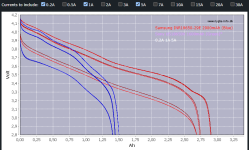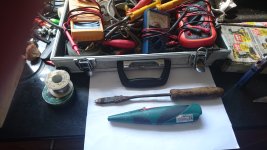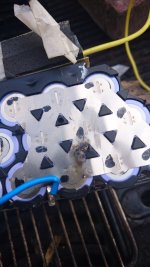They have a comparison database, but I haven't used it. I almost always am just going there to get discharge curves and other data for various cells to post in people's threads where they are asking about whether that cell will work in their application (they don't usually know what cell they have, so I cant' often do this).
The green cell page doens't have any specs in it's table to compare to the purple one, so can't tell if they are the same.
The important thing isn't specifically the actual chemistry, but the voltage ranges they operate within. So fo the purple cell taht's 3.62v nominal (meaning average voltage near the middle of the total capacity usage), and 4.2v max (HVC), and 2.5v min (LVC). The green cell has no data there.
Going to the lygte-info.dk comparator
for
Samsung INR18650-29E (purple)
and
Sony SF US18650V (green)
also has no specification or voltage data for the green cell, so no comparison for matching htem up can be made.
It does give this chart showing the green cell is way smaller in capacity and doesn't handle loads as well as the purple, so it would take at least twice as many of those cells in parallel to make the same kind of pack as t he purple, if they were each their own separate pack.
View attachment 338024
and these are the pages for them
showing the official specs in text and actual results in images below
View attachment 338020
Official specifications:
- Nominal Capacity: 2,850mAh (0.2C, 2.50V discharge)
- Typical Capacity: 2,850mAh (0.2C, 2.50V discharge)
- Minimum Capacity: 2,750mAh (0.2C, 2.50V discharge)
- Charging Voltage: 4.20 ± 0.05 V
- Nominal Voltage: 3.65V (0.2C discharge)
- Charging Method: CC-CV (constant voltage with limited current)
- Charging Current: Standard charge: 1,375mA
- Charging Time: Standard charge: 3hours
- Max. Charge Current: 2750mA (not for cyclelife)
- Max. Discharge Current: 2,750mAh (continuous discharge), 8250mAh (not for continuous discharge)
- Discharge Cut-off Voltage: 2.50V
- Cell Weight (max. (g): 48g
- Cell Dimension: Diameter(max.) : 18.40 mm, Height(max) : 65.00 mm,
- Operating Temperature: (Cell Surface Temperature) Charge: 0 to 45°C, Discharge: -20 to 60°C
- Storage Temperature: 1 year : -20~25°C, 3 months : -20~45°C. 1 month : -20~60°C
View attachment 338021
Official specifications:











